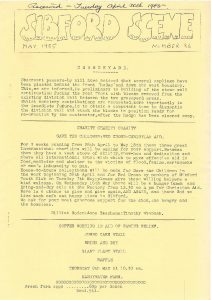Most of us in Sibford remember the elm at Sibford crossroads. Hallowed by Sibford Old Scholars it eventually fell victim to Dutch elm disease despite strenuous efforts to save it. Many of us also remember with affection the remains of the far more ancient elm on the opposite side of the road, first adopted by the Old Scholars as their emblem in 1907.
In an account taken from the O.S. Magazine of 1935 Joshua Lamb said that at one time a large branch reached horizontally across the main road and “this was a favourite resort of the village boys who delighted in dropping missiles on the carrier’s cart when passing underneath.”
In 1893, during a terrific snowstorm, the main portion of the head was blown off and this, with the unsafe horizontal branch was sold to William Poulton for £4.13.6 to make into boards. Two hundred and fifty seven growth rings were counted showing that the tree must have been about three hundred years old. Joshua’s uncle Septimus Harris sent a poem on its demise to the Banbury Guardian suggesting that soldiers in the Civil War might have passed it on the way to the battle of Edgehill.
Such trees give us great links with the past,and are one of the most precious parts of our heritage.
People in villages have long memories and a chat with one or two of the older residents will reveal many interesting details.
Mr Fred Lines remembers, as a child, planting an acorn near what is now the electricity substation in Temple Mill Lane. It is now a sizeable oak tree, over 70 years old! Fred’s father helped John Lamb plant many of the lovely trees in “Oddies field” and had to go round watering them in dry weather.
It is sad that since 1947 this country has lost 30-50 per cent of its ancient woodland, together with miles of hedgerow containing many both mature and young trees.
Each species of tree has its own population of insects which supply part of the vital food chain supporting other wildlife. Hedges too provide shelter and food, and a habitat for so many of our wild flowers. So,when trees and hedges go birds and many other forms of wild life suffer.
Fortunately we still have in Sibford many people committed to the care, protection, and planting of trees. It is vitally important and we can never do too much.
I would plead that in villages and rural areas we should make a particular effort to plant trees and hedges which are sympathetic to the environment, particularly native forest and hedgerow species.
Even now there may be someone in the village planning to fell a tree or uproot an old hedge, if so PLEASE reconsider the idea and ask yourself if it is really necessary.
Villages are not suburbs, but too many villages are fast coming to resemble them.
Joan Shields.
